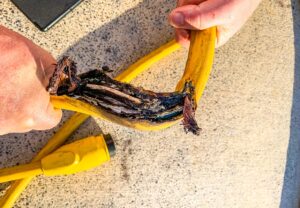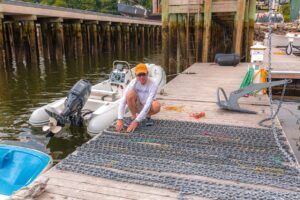When explaining how electricity moves through a wire, an analogy is frequently made to how water moves through a hose, comparing voltage, amperage and ohms in the wires to the volume, pressure and resistance of water in a hose. People tend to understand this analogy very well and can easily visualize electricity flowing through wires.

Most people have also experienced the failure of a water hose, suddenly bursting along the hose or at the end-fitting. Aside from being unexpectedly soaked while washing the car or connecting the sprinkler, little harm can come from this mishap.
Now imagine your boat’s electrical cord bursting in the same manner. It’s a significantly more exciting and definitely more dangerous occurrence. No, that couldn’t happen, you say. Think again, it happens more often than you realize.
Boat shore power cords are amazingly durable. They tolerate staying out in the cold, heat, rain and sometimes even in the snow. They’re walked on and even driven over at times. The ends are occasionally dropped in salt water and rarely dried out properly. They’re often given to high school students working summer jobs, who have little idea how to connect them to high voltage pedestals correctly. They’re twisted and thrown in wet moldy lockers and ignored for months at a time. Did I mention they are quite durable? Well, they are, but not indestructible.
According to accident investigation data, 55% of boat fires are caused by electrical sources, and of those, nearly half can be attributed to shore power. That should be a scary enough statistic to encourage everyone to take shore power cords seriously.
It’s no secret water and electricity do not mix well, yet we deal with them dangerously close to each other each time we connect our boats to shore power. The condition of our shore power cord terminal ends needs to be inspected and maintained more often than most boaters do, and they are ignored at our peril. A fire at McCotters Marina & Boatyard in Washington, NC, that destroyed 20 boats and did $23 million in damage was attributed to a boat’s shore power connection.
Preventing Problems
If your boat has the ubiquitous 30- or 50-amp three-prong terminal connectors, regularly inspect the terminals for corrosion or water migration into the connector. If the end on your cord is not a factory molded unibody construction, but rather one that can be easily disassembled, disconnect the cord at both ends, remove the outer cover and inspect the wire connections to the terminals. The screws capturing the wires against the terminals can loosen, creating resistance. Resistance in electrical connections is a treacherous enemy, as it is frequently hidden and goes unnoticed until it creates enough heat to spark a live fire.

If your cord ends are molded unibody construction, they still need to be inspected. Examine the ends of the shore power cords on a regular basis. Look for discoloration or melting around the blades of the plug (male end). Look for water intrusion and corrosion around the base of the blades where they enter the rubber. Similarly, examine the female end of the cord, around the slots on the connector.
Examine the face of the inlet on the boat and look for discoloration or melting around the blades and the inlet. Also examine the receptacle on the dock and look for discoloration or deterioration around the slots.
When, not if, your shore power cord’s end falls in the water, don’t just shake it off and plug it in. Thoroughly dry all the components, including rinsing with fresh water and drying to remove salt deposits. After drying, spray the end with electrical contact cleaner to disperse any remaining water.
The process of repeatedly coiling and uncoiling shore power cords, whether in a power retrieval system or by hand, can twist the internal wires within the outer casing. This twisting can lead to abrasion and resistance within the wires. I’ve seen cords spontaneously explode in the middle, where this abrasion and resulting resistance caused arcing within the cord. If your cord has visible signs of twisted wires within the cord, it should be discarded and replaced.
While it may not be an electrical hazard, keeping the cord’s outer sheathing clean is equally important to maintaining the service life. Contrary to their popularity, avoid using any form of solvent or petroleum distillate. These products will soften the rubber sheathing and actually cause it to get dirtier faster. A magic eraser, good quality degreaser/cleaner and elbow-grease is the best at cleaning cords. Follow the cleaning with a sealer designed for protecting rubber and plastic from UV degradation.
An easy way to protect your power cord is with a simple cover that wraps the cord with a Velcro closure. The covers are made of a durable Sunbrella material that keeps the cord from getting stained and marked on pier surfaces and pilings.
To further reduce potential risks associated with shore power connectivity, investigate the use of SmartPlug TM cord-ends, which connect more securely and make disengagement less likely.
For more information on shore power electrical ground fault issues, refer to the Shore Power Paradox article at marinalife.com/ShorePower
SAFE STEPS FOR CONNECTING SHORE POWER CORDS
- Turn off the boat’s shore power connection breaker before connecting or disconnecting the shore power cord to the boat.
- Connect the shore power cord to the boat FIRST.
- Turn off the breaker on the dockside shore power pedestal before connecting the cord to the pedestal.
- If your boat is equipped with a polarity detector warning indicator, look for reversed polarity and immediately turn off breakers and disconnect the cord if detected.
- Always use locking rings to secure the cord, reduce stress on the connectors and prevent accidental disengagement.





